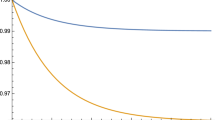Abstract
In this paper, we investigate the probabilistic characteristics of systems driven by dichotomous Markov noise (DMN), described by an external random increasing and decreasing shocks. Based on the DMN, we define two new aging classes of the increasing/decreasing renewal dichotomous Markov noise (IRDMN/DRDMN), which are separated by an exponential steady state regime in the long time behavior. In addition, a moment inequality is derived for the system whose life belongs to DRDMN class. This inequality to devise a nonparametric testing procedure for exponentiality against an alternative DRDMN life distributions.



Similar content being viewed by others
References
Ahmad IA (1992) A new test for mean residual lifetime. Biometrika 79:416–419
Asha G, Nair UN (2010) Reliability properties of mean time to failure in age replacement models. Int J Reliab Qual Saf Eng 17:15–26
Bena I (2006) Dichotomous Markov noise: exact results for out-of-equilibrium systems. Int J Mod Phys B 20:2825–2888
Bicout DJ (1997) Green’s functions and first passage time distributions for dynamic instability of microtubules. Phys Rev E 56:6656–6667
Harandi FM, Yarahmadian S, Sepehrifar M, van Gelder PHAJM (2014) The dichotomous Markov process with nonparametric test application, a decision support method in long-term river behavioral analysis: The Zayandeh-Rud River, a case study from central Iran. Stoch Environ Res Risk Assess 28:1889–1896
Ibarahim A, Sepehrifar M (2009) On testing alternative classes of life distributions with guaranteed survival times. J Comput Stat Data Anal 53(4):857–864
Ibrahim A, Mugdadi AR (2010) Higher order equilibrium life distributions. IEEE Trans Reliab 59(1):66–73
Izadkhah S, Kayid M (2013) Reliability analysis of the harmonic mean inactivity time order. IEEE Trans Reliab 62:329–337
Kantam RRL, Priya MC, Ravikumar MS (2014) Likelihood ratio type test for linear failure rate distribution vs. exponential distribution. J Mod Appl Stat Methods 13:174–186
Kolesnik AD, Ratanov N (2013) Telegraph processes and option pricing. Springer, New York
Lee AJ (1990) U-Statistics: theory and practice. Marcel Dekker Inc, New York
Li X, Xu M (2008) Reversed hazard rate order of equilibrium distributions and a related aging notion. Stat Papers 49:749–767
Ridolfi L, D’Odorico P, Laio F (2011) Noise-induced phenomena in the environmental sciences. Cambridge University Press, Cambridge
Mahrooghy M, Yarahmadian S, Menon V, Rezania V, Tuszynski Jack A (2015) The use of compressive sensing and peak detection in the reconstruction of microtubules length time series in the process of dynamic instability. Comput Biol Med 65:25–33
Marshall AW, Olkin I (2010) Life distributions: structure of nonparametric, semiparametric, and parametric families. Springer, New York
Mitra M, Anis MZ (2008) An L-statistic approach to a test of exponentiality against IFR alternatives. J Stat Plan Inference 10:3144–3148
Shaked M, Shanthikumar JG (2010) Stochastic orders. Springer, New York
Sepehrifar M, Khorshidian K, Jamshidian AR (2015) On renewal increasing mean residual life distributions: an age replacement model with hypothesis testing application. Stat Probab Lett 96:117–122
Yarahmadian S, Barker B, Zumbrun K, Shaw SL (2011) Existence and stability of steady states of a reaction convection diffusion equation modeling microtubule formation. J Math Biol 63:459–492
Yarahmadian S, Yari M (2014) Phase transition analysis of the dynamic instability of microtubules. Nonlinearity 27(9):2165
Author information
Authors and Affiliations
Corresponding author
Rights and permissions
About this article
Cite this article
Sepehrifar, M., Yarahmadian, S. Decreasing renewal dichotomous Markov noise shock model with hypothesis testing applications. Stat Papers 58, 1115–1124 (2017). https://doi.org/10.1007/s00362-016-0740-4
Received:
Revised:
Published:
Issue Date:
DOI: https://doi.org/10.1007/s00362-016-0740-4




